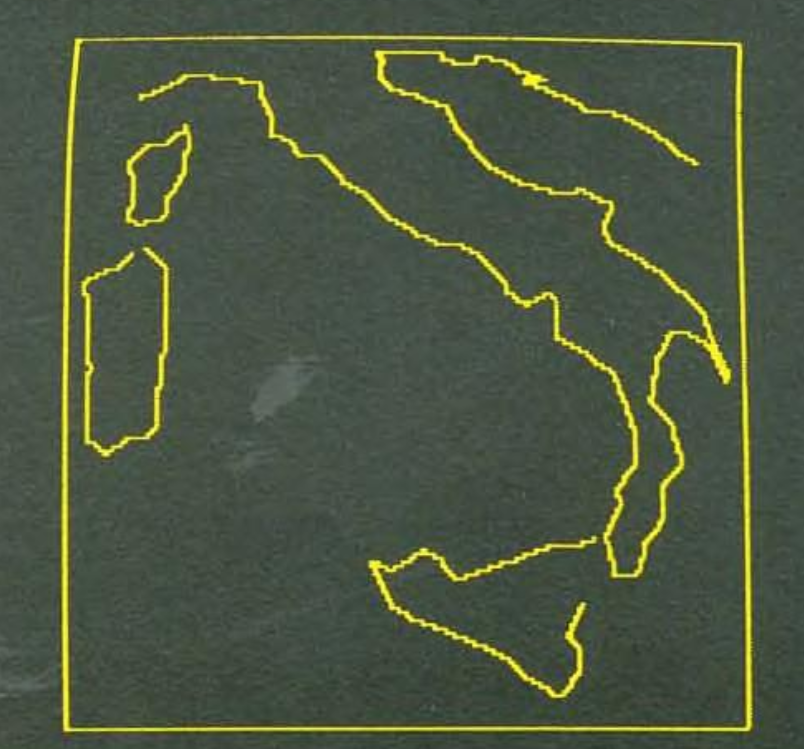
Art via Francesco Petroni in the Italian magazine MC Microcomputer, Oct. 1981.
It is in some ways mysterious that we haven’t had more adventure games in languages other than English.
Still, as we’ve seen from Australia and the UK, for adventures to be made there needs to be infrastructure in terms of number of computers in public hands, and companies willing to publish games. So while we have Acheton dating back to almost primeval days, and a single odd 1980 game for the UK101, we really don’t have UK adventures start going until 1981. For Australia, the only 1980 example we have is almost completely plagiarized from a game in a 1979 US magazine.
Alternately (or additively), a country may just not have had exposure to adventure games. They specifically might have missed the “mainframe wave” created by Crowther/Woods Adventure. Japan didn’t really have the adventure game concept “filter in” until Omotesando Adventure in 1982. (As presented in the magazine which printed it, adventures were a “New Type” of computer games.) They started their exposure with Mystery House and other Apple II imports instead of mainframe games.
In the case of Italy, they had local mainframes (even developing some back in the 1950s) and they were already well-established with home computer amateur development by 1980. Yet, it took until 1982 for an adventure game to appear.
A game that is essentially required to be played in English would not necessarily have made in-roads. For one of our authors today, Enrico Colombini, his first exposure to adventures was indeed the classic Adventure, but on a foreign mainframe (or at least mini-computer) and essentially by accident.
Enrico started the electronics store EC Elettronica in 1980 with his wife (Chiara, also a co-author on today’s game) and two of his friends; that same year they were exhibitors at a fair in Milan. They were setup near a Motorola stand with a “expensive looking” computer that was very large, and Enrico wandered over and read the iconic opening from the screen:
You are standing at the end of the road before a small brick building. Around you is a forest. A small stream flows out of the building and down a gully.
Since the booth workers didn’t mind, Enrico started typing, using his “rough English”. He “persi il senso del tempo”, that is, lost all sense of time. He eventually came to a sword planted in a rock making a humming sound, but had to stop when the fair closed. The sword in the rock is not from Crowther/Woods Adventure, but rather Adventure 550, with additions by David Platt. Once extracted, it actually sings when used on an ogre.
The sword halts in mid-air, twirls like a dervish, and chants several bars of “Dies Irae” in a rough tenor voice. It then begins to spin like a rip-saw blade and flies directly at the ogre, who attempts to catch it without success; it strikes him full on the chest.
However, Mr. Colombini never got to that part, because the adventure program was gone the next day.
EC Elettronica had a PET 2001 to keep track of company stock, which was eventually replaced with an Apple II (and disk drives). The computer was used for recreation in addition to work.
In quel periodo tutto era nuovo, e quasi ogni programma era interessante.
In this time period, everything was new and nearly every program was interesting.
Enrico came across a disk marked Apple Adventure, and found a game recognizably close to the one he had played, so was able (after some hacking to fix the save file mechanism) to play to the maximum 350 points. He credits it with teaching him English.

This is a straight port by Peter Schmuckal and Leonard Barshack, so I haven’t written about it before.
Enrico Colombini and his wife (Chiara Tovena) then embarked on writing their own game, self-publishing for Apple II early in 1982 under the name Dinosoft at a local shop in Pescia, creating “una confezione molto artigianale fatta con adesivi letraset“, that is, “a very artisanal package made with Letraset stickers”.
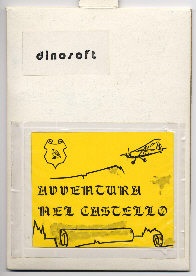
From the author, and unfortunately the largest image of this we have, but I guess it fits with the “artisanal” part.
Some “firsts” are obscure (like Bilingual Adventure), some are well-known and celebrated. Avventura nel Castello ended up being one of the legendary Italian games, and had multiple reprints: in 1984 for J. Soft (still Apple II), in 1987 for Hi-Tech (for DOS), in 1996 (independently, also for DOS) and finally in fancy modern form in 2021, including a translation into English (Castle Adventure).

Advertising for the J. Soft version. Via eBay.
I’ve been playing the English translation and cross-checking with the first Italian version for Apple II. I can say they are fairly close, and the original is just as wordy as the newer version is. This is Apple II, with a whopping 48K of memory, and the author — clearly thinking directly of Adventure — has the memory space and inclination to be wordier than Scott Adams.
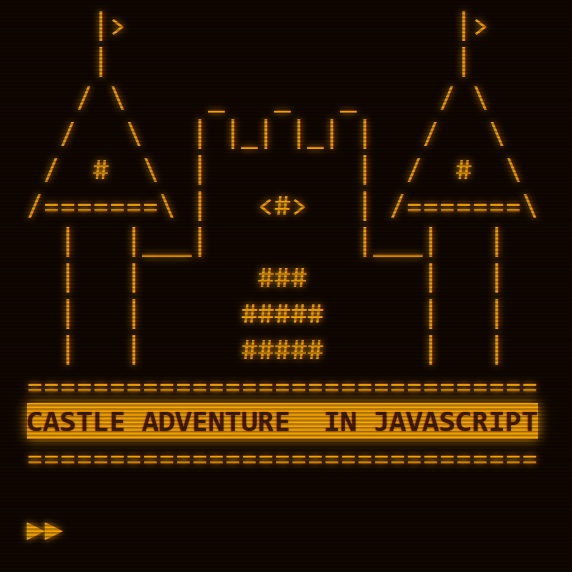
This opening genuinely is duplicating the original opening.
You’re piloting your single-seater over the desolate Highlands of Scotland.
You’ve just flown over Loch Ness…
Suddenly, the engine misfires.
The controls aren’t responding!You’re plummeting!
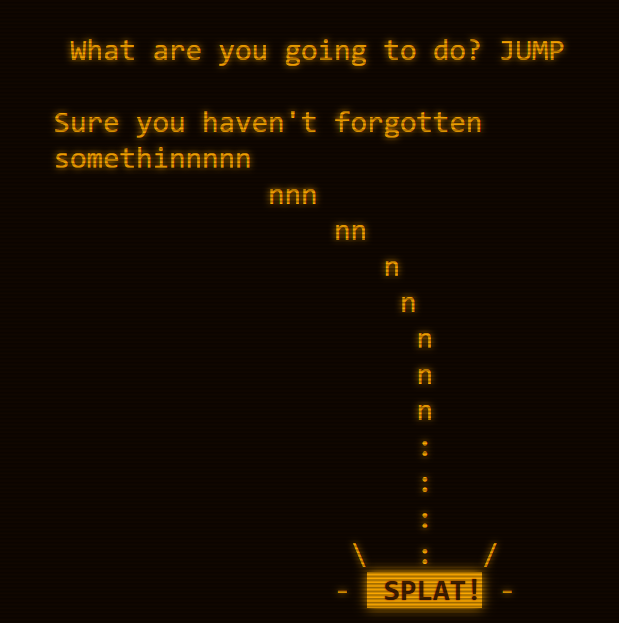
You’re supposed to guess the “aren’t you forgetting something” that there’s a parachute, and TAKE PARACHUTE (GET doesn’t work).
What are you going to do? TAKE PARACHUTE
Oh, look. There is a parachute. I hadn’t seen it.
I promise you that, from now on, I’ll be much more careful, and will
scrupulously report all the objects around you.Anyway, you’ve got it on now.
You’re plummeting!
(This is probably the fairest “get an item that is not described in the room” puzzle we’ve seen in All the Adventures. The text cues what to do quite strongly. See Escape from Colditz for an unfair example.)
In Italian, the game wants PRENDI PARACADUTE.
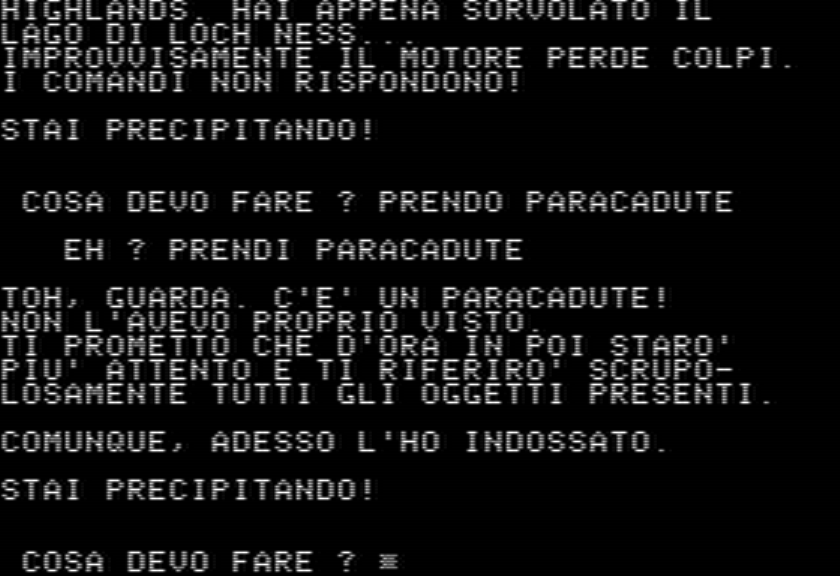
The conjugation is important. I struggled for a while because I was typing PRENDO PARACADUTE (“I take the parachute”) rather than PRENDI PARACADUTE (“You take the parachute”). This is the “I am your puppet” style perspective where you assume you are a step removed from your avatar. This can differ based on the norms of how a particular language approaches adventure games. I remember having a bewildered discussion with an Italian back in the 90s claiming saying “you” want to do something felt bizarre when “I” was the one in the story, but they were insistent that I was being the bizarre one.
This game also quite specifically wants the imperative. So the next step isn’t SALTO (thinking “I jump” in present tense) or SALTI (“you jump” in present tense) but rather SALTA, in imperative.
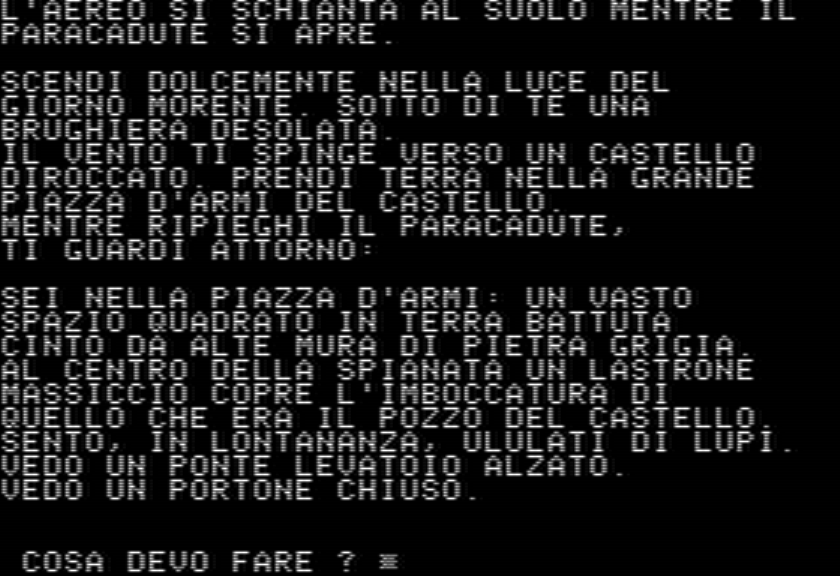
Switching back to English:
What are you going to do? JUMP
Just in time!
The plane crashes to the ground, as your parachute opens.
You gently descend in the dying daylight. Below you appears a desolate moor. The wind pushes you towards a ruined castle. You land in the castle’s large parade ground.
While you fold away your parachute, you look around:You’re on the parade ground: a vast, square, beaten-earth clearing, surrounded by high, grey stone walls.
In the center of the courtyard, a massive slab covers the mouth of the castle’s well.
In the distance, you can hear the howling of wolves.
I can see a raised drawbridge.
I can see a closed door.
There’s not much we can do with the massive slab or drawbridge (I think) so the only way to make progress now is to open the door and go in the castle.
What are you going to do? ENTER DOOR
The door slams shut, without leaving the slightest crack.
You are in a large atrium, immersed in darkness. An eerie phosphorescence emanating from the walls allows you to just about distinguish the contours of the room.
A marble staircase rises upwards, dimly lit by the greenish light, but gradually disappearing into the darkness.
I can see a coat of arms painted on the ceiling.
Here we are trapped, and now our main objective is to escape.
My map so far, just of the ground:

It’s nearly all accessible and peaceful, and even though there’s some vivid descriptions, sort of sparse. This game is not trying to stuff itself with items. That might mean there are enough floors that we get lots of items, or it might just mean there’s hidden things. I’m going with the presumption that anything in the room description can’t really be used and only the items that get listed after are important, but if I get seriously stuck I’ll reconsider.
First, a tour of the ground floor, then a quick trip to the basement, and then I’ll show off the maze on the second floor.
You’re in a large living room, furnished with numerous sofas and comfortable armchairs. In the centre of one wall is a monumental fireplace, built with blocks of carved stone.
Although the fire has been out for centuries, the room still seems to be illuminated by a wavering reddish light.
I can see a cat crouched on the ground.
Using the presumption I just spoke of, the sofas and fireplace don’t need to be fiddled with, but the cat is important. You can feed the cat some milk from the kitchen, and then can pick it up. I haven’t found any birds or mice to sic it on yet, though.
Elsewhere:
You’re in an elongated room without any furniture. The walls are lined with portraits of clan chiefs, lairds and dignitaries who have governed the castle and lands over centuries.
The portraits seem to stare at you with malevolent eyes. One in particular, that of MacCallum IV, seems to follow your movements with a gaze full of murderous hatred.
This feels like it is just meant to be lore. You can’t move the portrait or take it. While I’m at it, though…
What are you going to do? PULL PORTRAIT
Gonnae no dae that. I’d prefer not.
…does the Italian actually attempt the equivalent of a Scottish accent? That’s past my pay grade (or rather, my dimly-remembered college Italian).
Other map highlights include:
- a rampart that you can walk around, where you can see fog and hear “cawing of the crows”
- a mirror room that takes a little while to exit because you can accidentally run into a mirror rather than get out, this seems to be random
- a music room where you can play the bagpipes: “You deserve to be part of the Royal Scots Dragoon Guards! (…playing the drums)”
- a library with a book on Ancient Gaelic; inside the book is a sheet with the word “IOT”
- a mysterious bricked-off door
- some “heavy stone balls” in a room with pieces of an ancient war machine that can’t be picked up
- an Alchemist Cell with a book bound in human skin that requires a “tool” to open it
The last one’s a bit spookier than the others, but there’s still no active antagonism going on.
You are in the Alchemist’s cell. All around are crucibles, pestles, copper stills and bizarre glass containers of extremely contorted shapes. On the shelves are many heavy tomes of magic, alchemy and spells. In the centre of the room is a small table that rests on three legs shaped like the paws of some monstrous animal. On the table is a single heavy volume bound in black leather:
“The Sorcerer’s Apprentice”
Going down, on the other hand, is a bit more threatening. The way down is to look at the seal in the opening atrium.
The clan motto is written there.
“The sassenach will fall”
Suddenly, a trap door opens beneath your feet.
You are in the castle dungeon, once called ‘The Tomb’. The floor is covered in skeletons.
I can see a hole on the wall.What are you going to do? EXAMINE SKELETONS
It is our common fate. But can’t you think of something happier?
You’re in the dungeon.
I can see a hole on the wall.What are you going to do? EXAMINE HOLE
It is narrow and deep, and, at the end, there’s something that looks like a button.
You’re in the dungeon.
I can see a hole on the wall.What are you going to do? PUSH BUTTON
Should you stick your arm through the hole? YES
A blade snaps down, slicing your arm cleanly off.
While you’re bleeding to death, let me tell you that you’ve been behaving rather recklessly.
I assume I just poke the button with something long, but I haven’t found a great candidate yet. Going up from the Atrium gets you trapped in a different way.
What are you going to do? U
You’re at the top of the stairs. The steps end abruptly in front of a smooth stone wall.
What are you going to do? EXAMINE WALL
I cannae see any holds or cracks.
You’re at the top of the stairs.
What are you going to do? PUSH WALL
The wall rotates on itself… and snaps shut behind you.
You’re at the entrance to the immense magical maze, of which it is said that all passages lead to this one room, from where neither man nor thing can escape. There are two skeletons on the ground. On the wall, written in blood are the words:
‘Impossible to get out of here’
This seems to be an absolutely classical maze, as those who derived their games more or less directly from Adventure are cursed to make.
I’ll hopefully have that mapped out by next time, and maybe figure out a use for the cat. As far as how long this goes, I’m not sure; the game lists 1000 points total, but it isn’t a normal rate of score increase. Even without doing much I had around 100 points, so I suspect if we normalized to, say, Scott Adams game length, we’d have a 100 point game. Some of the Scott Adams games took a while to get through, though!


The snippet on the history of the game and the peculiar differences between Italian action-verbs and English action-verbs (“You” vs “I”, Imperative) are extremely interesting. Now I wonder:
– Whether Italian players playing tabletop RPG say “My character” or “I” (or “you”?)
– Whether later Italian games aligned to the English “I”, and if so when.
In French, the “You” imperative and the “Je” indicative are the same, so hard to know which one was used.
This came up on Mastodon. There is Italian IF that uses “I”
https://oldbytes.space/@JJFlash/112287474726672473
I wouldn’t call it a peculiar difference between Italian and English. “Take [the] parachute” is a second-person imperative form, just like “prendi [il] paracadute“. If native English speakers mentally insert an “I” at the start of the sentence (thus changing it to a first-person indicative form), that’s an interesting fact to me and I’d join my fellow Italians in calling that bizarre. When I play IF in English I always think I’m writing in second-person imperative, even when the protagonist is supposed to be me (e.g. in Violet).
It’s one of those things I need to survey more carefully as I rack up languages.
My primary influence was Infocom, here’s how the manual goes:
>(game) usually acts as if your sentence begins I want to…, although you shouldn’t actually type those words.
Typing GET LAMP isn’t really a “grammatical sentence” at all in English; if you shouted out the words out of context it wouldn’t make sense. So there’s always an implicit assumption there’s some unstated avatar that the commands are being given to, but sometimes those commands are really to “yourself” (Infocom) to a “puppet” (Scott Adams, Softporn Adventure) or to even more exotic variants, like Cyborg which uses “we” and considers the player cojoined with the computer reporting the results.
For the button push, have you tried using a bone from the skeletons? A bone seems like a thing that would be fair to assume the presence of, even though it’s not explicitly mentioned in the room description. And the game may have already told you that sometimes you need to look for things that should be there, though I guess it also promised to be more careful.
I remember when Marco Innocenti submitted the first Andromeda game to the IFComp there was a bit of discussion about how the Italian IF scene tended more toward elaborate descriptions and intuitive leaps in the puzzles than the English-speaking parser scene, which led to some agita when some players got stuck early. The unmentioned parachute reminded me of that, though it’s very fairly clued by the try-and-die and doesn’t waste any of your time since it’s the first move.
It is in fact a bone.
(I’m already through that puzzle, but nice catch still! In the middle of writing my next post. The responses to looking at the skeletons REALLY try to dissuade you from looking at the skeletons though, so ugh.)
Pingback: Avventura nel Castello: The Sorcerer’s Apprentice | Renga in Blue
I tried the English version in JavaScript, and I typed “search parachute” and it understood it correctly. I wonder if the Italian version works the same (sorry, don’t speak Italian).
I tried to test this but I’m not sure what word they’re using for “search” in Italian!
I’ve researched a bit, and downloaded the game. Fortunately it is non-minified JavaScript, and the author followed a multi-language-with-a-single-engine approach. I found this in thesaurus.js:
(“non_trovato” is italian for “not found”.)
So the verb is cerca and the noun is paracadute (this last I found by Google Translator, while the first one was misleading since it suggested ricerca without any synonyms).
Indeed…
(“stai precipitando” is Italian for “you’re plummeting”. “appena in tempo” is Italian for “just in time”, “Toh guarda. C’è un paracadute. Non l’avevo proprio visto.” is Italian for “oh, look, it’s a parachute, I hadn’t seen it”…)
BTW, have you tried with help (it works in both languages) while in the plane?